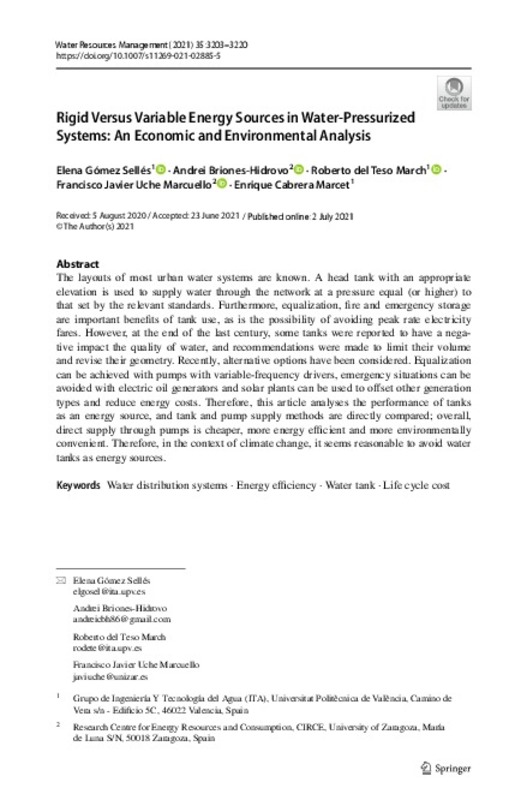Batchabani E, Fuamba M (2014) Optimal Tank Design in Water Distribution Networks: Review of Literature and Perspectives. J Water Resour Plan Manag 140(2):136–145
BOE (Boletín Oficial del Estado) (2020) Circular 3, 2020, de 15 de enero, de la Comisión Nacional de los Mercados y la Competencia, por la que se establece la metodología para el cálculo de los peajes de transporte y distribución de electricidad. BOE, 24 de enero de, 2020. Agencia Estatal Boletín Oficial del Estado, Madrid, pp 6953–6980
Cabrera E, Pardo MA, Cabrera Jr. E, Cobacho R (2010) Agua y energía en España. Un reto complejo y fascinante. Ingeniería del Agua 17(3):235–245
[+]
Batchabani E, Fuamba M (2014) Optimal Tank Design in Water Distribution Networks: Review of Literature and Perspectives. J Water Resour Plan Manag 140(2):136–145
BOE (Boletín Oficial del Estado) (2020) Circular 3, 2020, de 15 de enero, de la Comisión Nacional de los Mercados y la Competencia, por la que se establece la metodología para el cálculo de los peajes de transporte y distribución de electricidad. BOE, 24 de enero de, 2020. Agencia Estatal Boletín Oficial del Estado, Madrid, pp 6953–6980
Cabrera E, Pardo MA, Cabrera Jr. E, Cobacho R (2010) Agua y energía en España. Un reto complejo y fascinante. Ingeniería del Agua 17(3):235–245
Cabrera E, Gómez E, Soriano J, del Teso R (2019) Eco-layouts in water distribution networks. J Water Resour Plann Manage 145(1):04018088. https://doi.org/10.1061/(ASCE)WR.1943-5452.0001024
Clark RM, Abdesaken F, Boulos PF, Mau RE (1996) Mixing in distribution system storage tanks: Its effect on water quality. J Environ Eng 122(9):814–821
Dias AS, Kim H, Sivakumar PK et al (2013) Life cycle assessment: A comparison of manufacturing and remanufacturing processes of a diesel engine. Re-Engineering Manuf Sustain - Proc 20th CIRP Int Conf Life Cycle Eng 675–678
EPA (Environmental Protection Agency) (2002) Finished Water Storage Facilities. US Environmental Protection Agency. Office of Ground Water and Drinking Water. Washington
Everhart GJ (2010) Comparison of life-cycle energy of water storage tanks. University of Florida
Gómez E, Cabrera E, Balaguer M, Soriano J (2015) Direct and indirect water supply: An energy assessment. Proc Eng 119:1088–1097. https://doi.org/10.1016/j.proeng.2015.08.941
Grundfos (2019) Horizontal split case pumps. Booklet Data. Bjerringbro, Denmark
Jens N, Anders N (2014) Water supply in tall buildings: Roof tanks vs. pressurized systems. Grundfos Water Boosting. Grundfos. Denmark
Nee AYC (Editor) (2015) Handbook of Manufacturing Engineering and Technology, First. Springer London Heidelberg New York Dordrecht, Singapore
Petit-Boix A, Roigé N, de la Fuente A, Pujadas P, Gabarrell X, Rieradevall J, Josa A (2016) Integrated Structural Analysis and Life Cycle Assessment of Equivalent Trench-Pipe Systems for Sewerage. Water Resour Manage 2016(30):1117–1130. https://doi.org/10.1007/s11269-015-1214-5
Pillot J, Catel J, Renaud E, Augeard B, Roux P (2016) Up to what point is loss reduction environmentally friendly?: The LCA of loss reduction scenarios in drinking water networks Water Research 104:231–241
Raluy RG, Serra L, Uche J, Valero A (2005) Life Cycle Assessment of Water Production Technologies Part 2: Reverse Osmosis Desalination versus the Ebro River Water Transfer. Int J LCA 10(5):346–354
Rossman LA, Uber JG, Grayman WM (1995) Modeling disinfectant residuals in drinking-water storage tanks. J Environ Eng 121(10):752
Rossman LA (2000) Epanet2. Users Manual. US EPA, Cincinnati. USA
Stokes J, Horvath A (2006) Life Cycle Energy Assessment of Alternative Water Supply Systems (9 pp). The International Journal of Life Cycle Assessment 11:335–343
SV (Sustainability Victoria) (2009) Energy Efficiency Best Practice Guide Pumping System. Sustainability Victoria. Melbourne. Australia
Tangsubkul N, Beavis P, Moore SJ, Lundie S, Waite TD (2005) Life Cycle Assessment of Water Recycling Technology. Water Resour Manage 19:521–537. https://doi.org/10.1007/s11269-005-5602-0
Uche J, Martinez A, Castellano C, Subiela V (2013) Life cycle analysis of urban water cycle in two Spanish areas: inland city and island area. Desalination Water Treat 51(1):280–291. https://doi.org/10.1080/19443994.2012.716634
Uche J, Martínez-Gracia A, Carmona U (2014) Life Cycle Assessment of the Supply and Use of Water in the Segura Basin Int J Life Cycle Assess 19:688–704. https://doi.org/10.1007/s11367-013-0677-y
Walski TM (2000) Hydraulic design of water distribution storage tanks. Water distribution systems handbook, 10, McGraw-Hill, New York, pp 10.1–10.20
Walski TM (2012) Planning-level capital cost estimates for pumping. J Water Resources Planning and Management. https://doi.org/10.1061/(ASCE)WR.1943-5452.0000167,307-310
WC (Water Corporation) (2017) Design Standard No. DS 61. Water Supply Distribution - Tanks. October 2017. Water Corporation. Osborne Park. Australia
Wernet G, Bauer C, Steubing B, Reinhard J, Moreno-ruiz E, Weidema B (2016) The ecoinvent database version 3 ( part I ): overview and methodology. Int J Life Cycle Assess 3:1218–1230. https://doi.org/10.1007/s11367-016-1087-8
WHO (World Health Organization) (2017) Principles and practices of drinking-water chlorination: a guide to strengthening chlorination practices in small-to medium sized. World Health Organization. Regional Office for South East Asia. New Delhi, India
[-]









